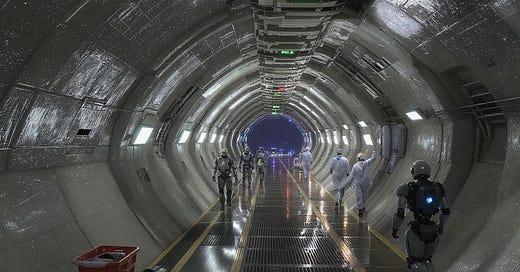Loring Air Force Base, Summer 2045
The promise of nanotechnology had once seduced the world with visions of immortality, instant healing, and total connectivity. But by 2045, its glow had faded. Systems embedded with nanotech showed signs of systemic degradation: neural interference, mutations in synthetic cells, failures in BCI synchronization. The technology that once seemed divine now buckled under the weight of its own ambition.
Wars raged across continents. From the Sahel to the Balkans, sovereign states collapsed under debt, internal uprisings, or the excesses of their AI systems. With national treasuries empty and corporate bailouts dwindling, countries abandoned their nano research programs one by one. Global production of neuro-chips slowed to a near halt. Money was the the driver and it became hard to find. Facilities that once buzzed with progress now echoed with silence.
At Loring Air Force Base, James Sylvester paced the length of the cold, neon-lit briefing room on the 8th underground floor. His face was more closed-off than usual, jaw clenched, shoulders stiff beneath the matte black of his suit.
— “We’ve lost three supply chains this quarter,” his logistics officer announced. “The graphite plant in Malaysia is offline. Our lab in Catalonia is silent. And we can no longer synthesize graphene at the purity required for Phase 9.”
Sylvester didn’t respond immediately. He tapped the table once, then leaned forward, voice dry.
— “And resources through our agents? Private suppliers?”
— “The legal market is dry. And even the grey zones are drying up. No one wants to risk supplying us with the Senate audits on military subcontractors. We need official funding.”
That afternoon, he connected via a secure line to the White House. On the other end: Madeline Kerr — fixer, kingmaker, and crisis handler. Sharp-tongued and short on patience.
— “I’ve read your report, Director Sylvester,” she began. “Let’s be frank: if you want more funding, we need a public victory.”
— “Our work isn’t designed for press releases.”
— “Maybe not. But PR moves budgets. Congress wants visible results. A miracle cure. A successful national lockdown. Something that sells.”
Sylvester’s brow twitched. — “You want a showcase.”
— “Exactly. Show that the Anunnaki project still matters. That it works. And you’ll get your parts. Your scientists. Whatever you need.”
The line went dead. Sylvester stood still for a moment. Then he turned to the dark glass separating him from the observation floor, where the test subjects waited. In the dim light, some stared back — expressionless, patient.
He murmured, to no one in particular:
— “Then we’ll give them their showcase.”
Outside, in the stormy whiteness of Maine, the power flickered. And deep underground, the machines stirred.
The next morning, an alert blinked red on Sylvester’s terminal. The neural alignment database — critical to tracking BCI calibration and subject response — had developed anomalies. He pulled up the logs. Neural baselines didn’t match. Synchronization timestamps looped. Patterns seemed falsified, scrambled.
He summoned his data integrity team.
"We’ve got corrupted entries in alignment records," he said, pacing. "Phase 7 through 9. How long has this gone unnoticed?"
No one answered immediately. A junior analyst adjusted her glasses.
"Sir... it looks like the system was validating its own errors. There was no outside alert because the patterns were self-reinforcing."
Sylvester narrowed his eyes.
"So we’ve been running false feedback loops for weeks. Months maybe. And the entire subject batch could be compromised."
His lead technician frowned. "We’re looking into potential causes. Could be internal — a decay in the storage cluster, or code corruption from the last update."
"Or it’s sabotage," Sylvester said flatly.
They fell silent.
"Find the source," he ordered. "Start from the oldest anomaly and work forward. I want a full chain audit. Today."
As the team dispersed, Sylvester stood at the edge of the lab, watching a test subject twitch involuntarily under a BCI halo. Was it a reaction — or just noise? The line was no longer clear.
He didn’t say it aloud, but the thought hung heavy: someone might be rewriting the system from the inside.
The machines kept humming. The floor below his feet vibrated. And Sylvester, hands clenched behind his back, stared into the dark.
This wasn’t a glitch. It was the beginning of a crack. In the circuit. In the mind. In control itself.
Sylvester didn’t sleep anymore. Or barely. Cold coffee in the morning, warm liquor at night. Always alone. Always in his office or wandering the too-long, too-white corridors. He had no family, no contact outside of work. His personal life had evaporated with each passing project phase.
He’d long believed he was in control. But after years of managing neural interfaces, lines of code, and bodies wired into void, he no longer knew what part of him was still human. He spoke rarely, and when he did, it was to give orders. People avoided him. He knew it. He didn’t care.
What he didn’t tell anyone was this: he no longer believed in the mission. Not truly. But he didn’t know how to do anything else. He walked, functioned, executed. A protocol in a loop. He drank to slow the gears in his head. It never worked for long.
Sometimes, in the silence of the service tunnels, he caught himself talking to no one. A half-sentence. A name. Then silence. Sometimes, he stared at his reflection in a window, not recognizing it.
One day, he stopped cold in the main corridor, just before the door to Level 9. He leaned against the wall. He felt like a corrupted loop himself. Part of him knew he was already on the other side. Not a superman. Not a tyrant. A cog. A suit on autopilot.
But he straightened up. Because there was still a showcase to build. A spectacle to produce.
And in the ruins, even automatons have roles to play.





